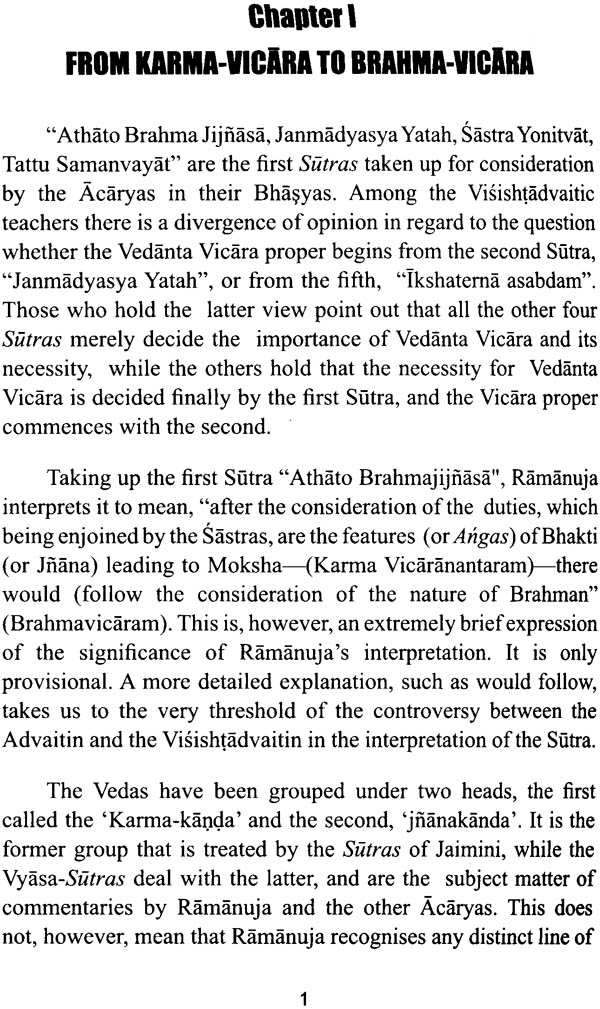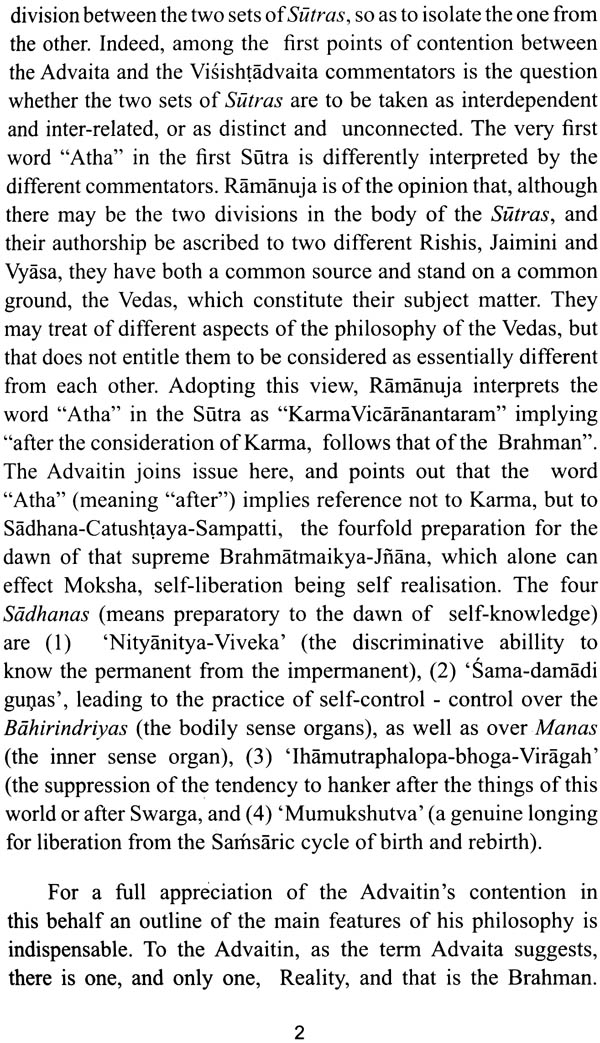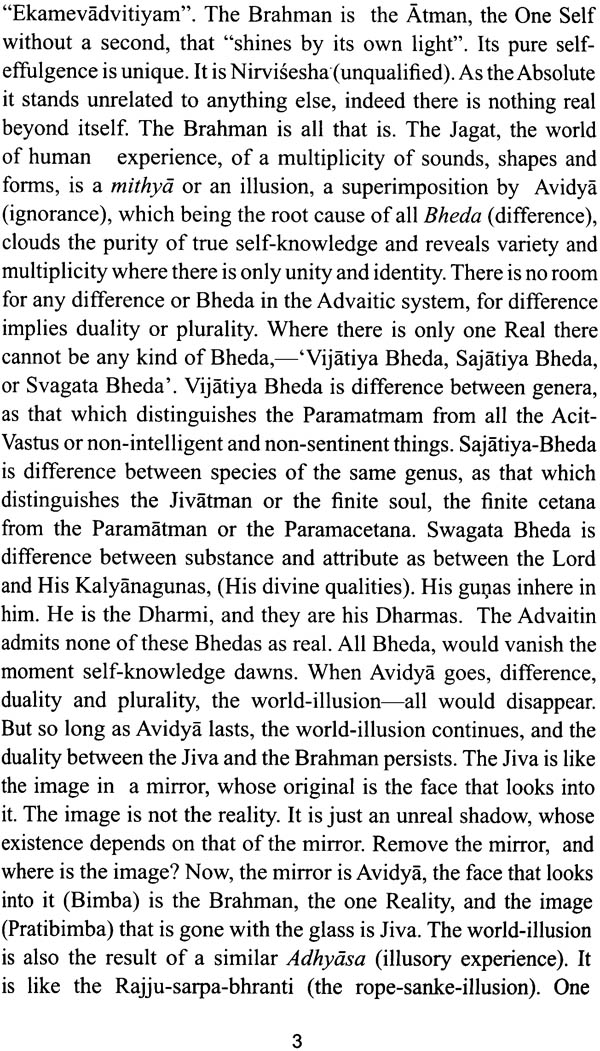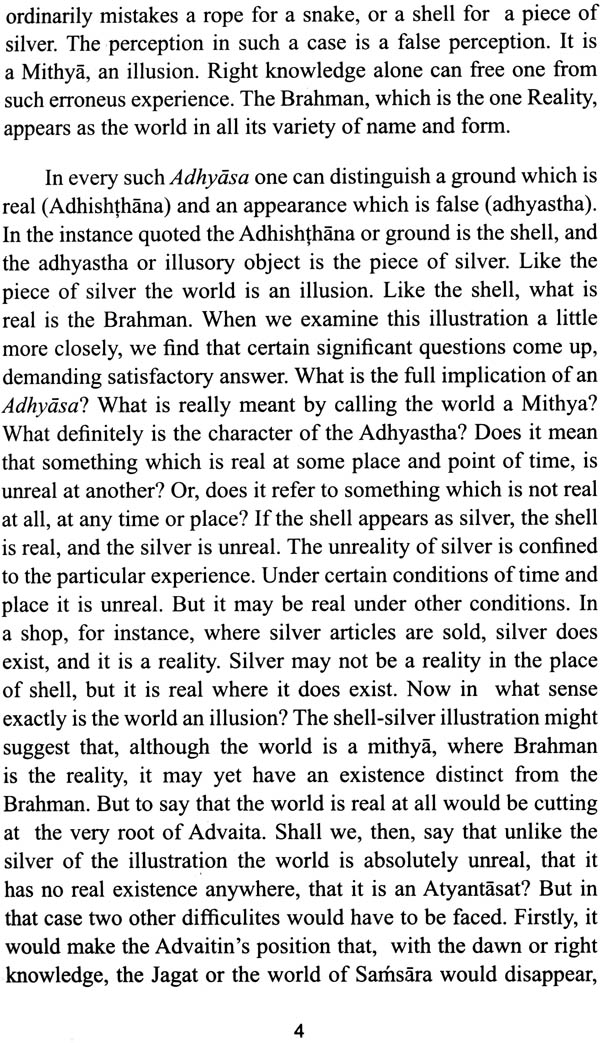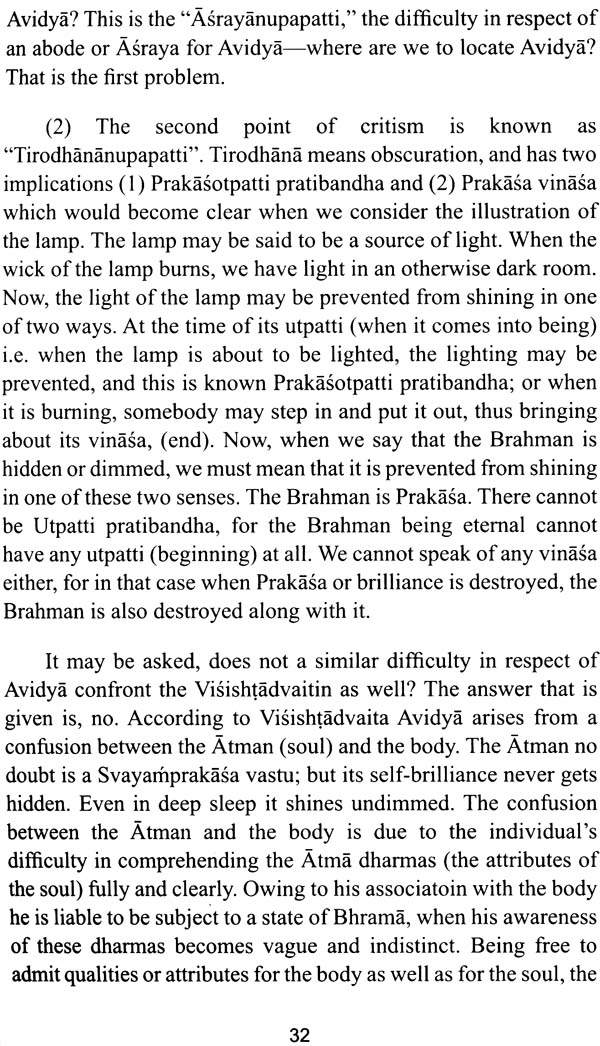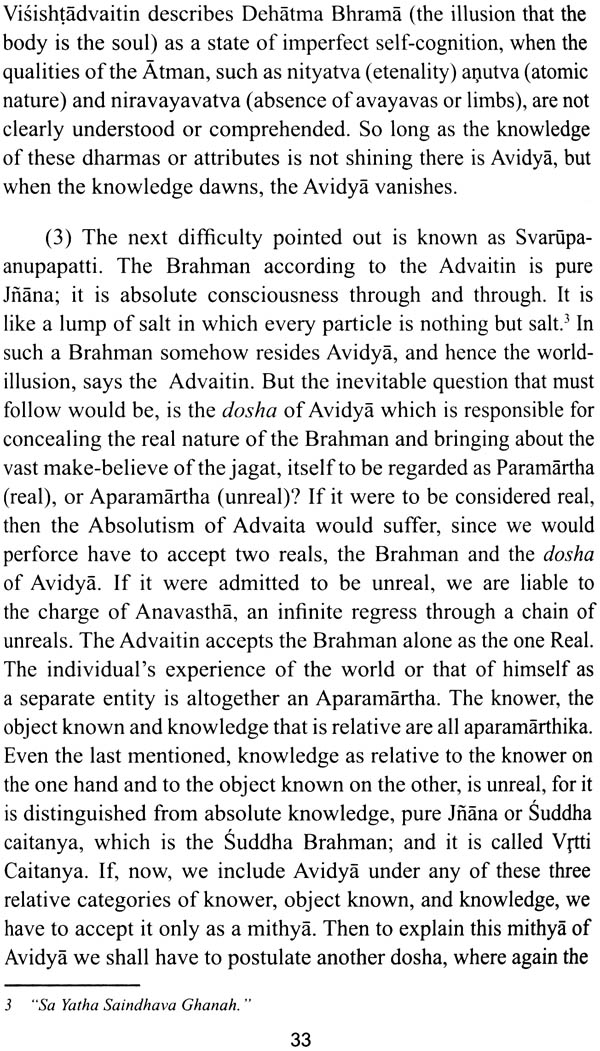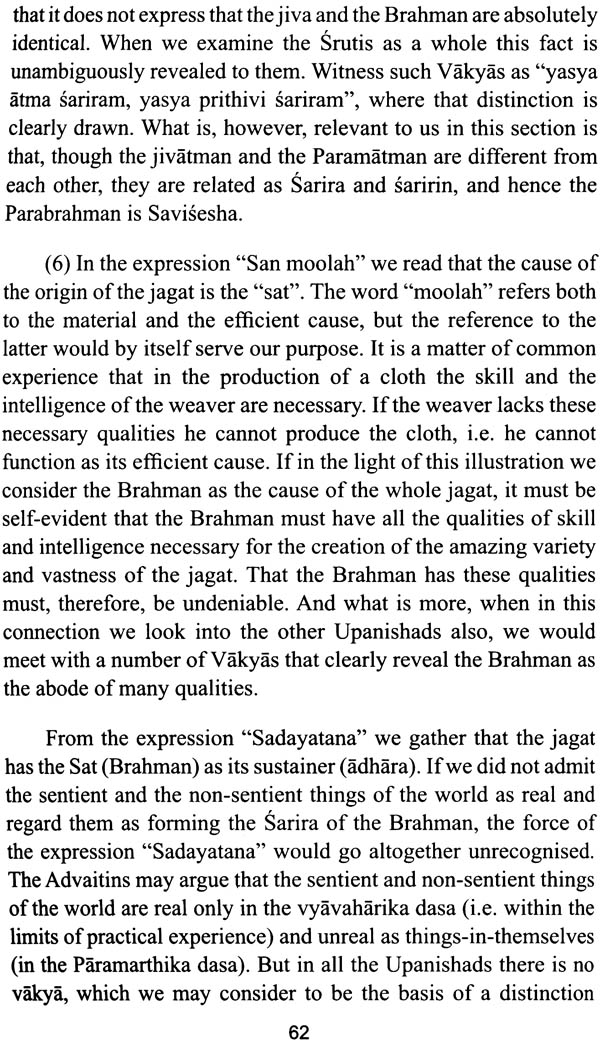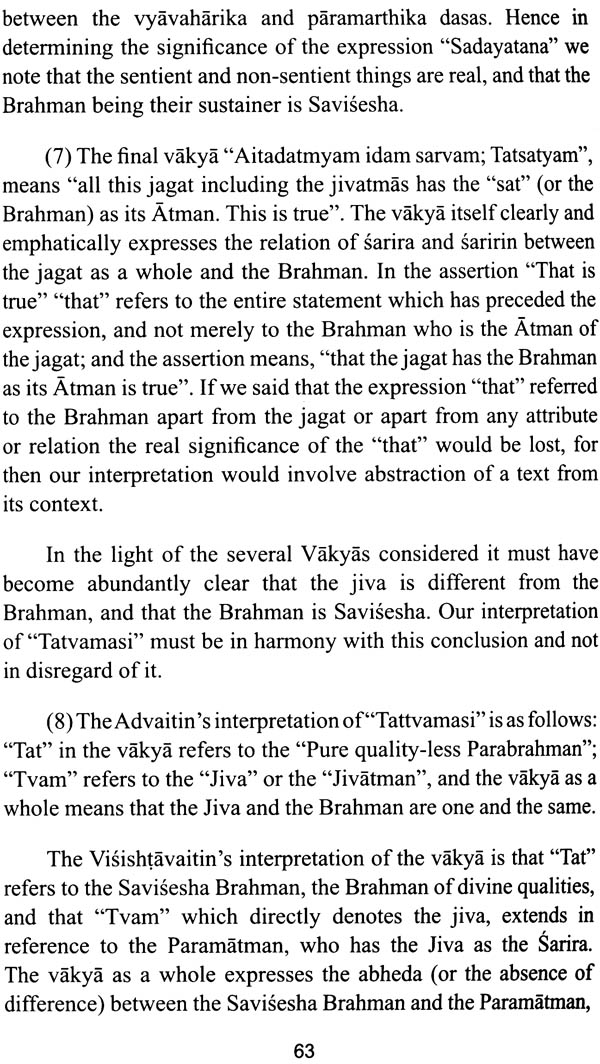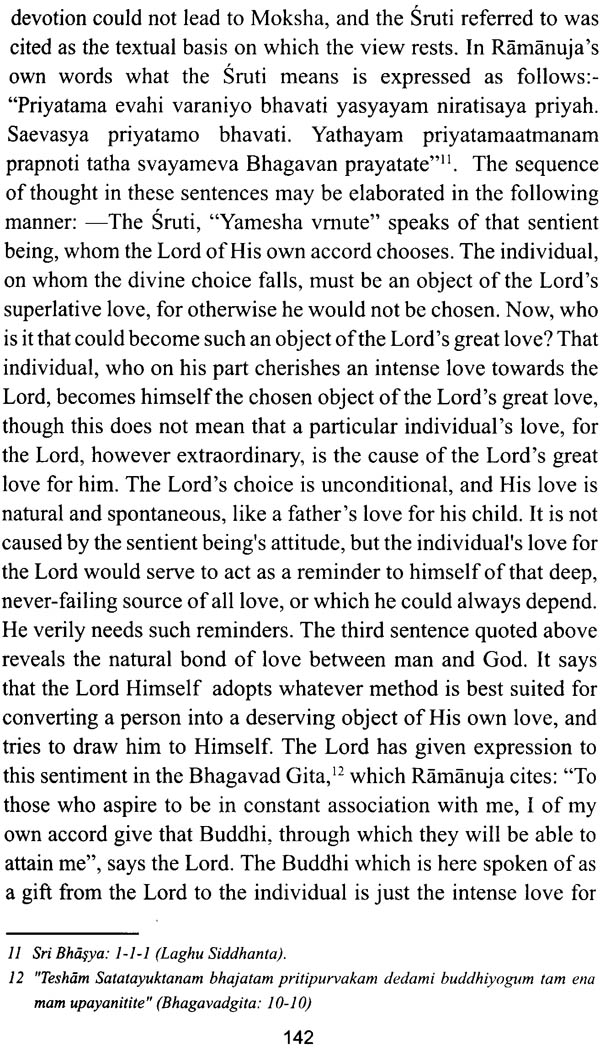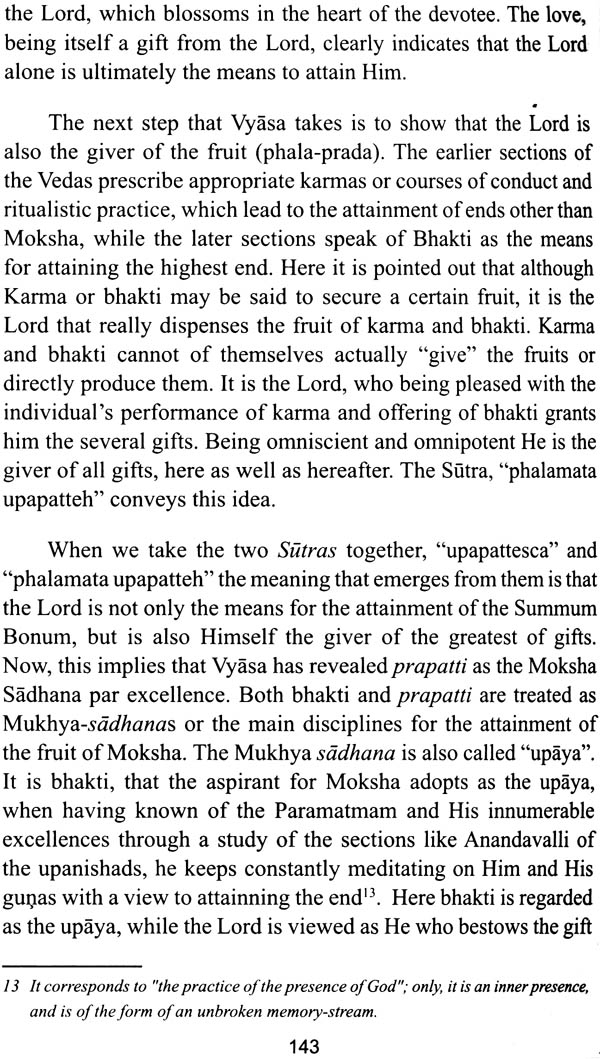
The Substance of Ramanuja's Sri Bhasya
Book Specification
| Item Code: | NAF256 |
| Author: | K. Seshadri |
| Publisher: | Bharatiya Vidya Bhavan |
| Language: | English |
| Edition: | 2012 |
| ISBN: | 9788172764647 |
| Pages: | 176 |
| Cover: | Paperback |
| Other Details | 8.5 inch x 5.5 inch |
| Weight | 170 gm |
Book Description
Professor K. Seshadri (1905-1983) was well-known in Chennai's religious and philosophical institutions as a sincere and erudite speaker who could present whatever subject he was speaking on with a rare clarity and relevance. Years of teaching philosophy in general and Indian philosophy in particular, combined with special training under the renowned Sri Karappangadu Venkatachariar Swamy, had endowed him with a mastery of the true spirit of the Hindu religion.
His career as a teacher of philosophy began at Pachiappa's College in Chennai. Prof. Seshadri continued his teaching career at the Madura College, Madurai, Tamil Nadu and Madras Government colleges. He joined the faculty at The University College, Trivandrum, Kerala in 1944, and taught there until his retirement in 1961.
Returning to Chennai after his retirement, Prof. Seshadri worked with various organizations, including the Southern Languages Book Trust, the Vivekananda Kendra Patrika, and the Call Divine, writing for and helping them to edit their many publications. Prof. Seshadri was also associated with the many research projects initiated by the Centre for Advanced Studies in Philosophy, University of Madras and participated in almost all of the centre's seminars.
A foundation was instituted by Sri. C.R. Pattabhiraman and Sri. 'LV Viswanatha Ayyar, to collect and compile Sri. C.P. Ramaswami Ayyar's papers and to propagate Hindu culture and religion; Prof. Seshadri, was engaged to carry out this task as the foundation's first director. Under the auspices of the CPo Ramaswami Ayyar Foundation, Prof. Seshadri delivered a series oflectures which were later published under the title, The Heritage of Hinduism.
Prof. Seshadri contributed articles on religion - Hinduism, Vaishnavism and soon-to The Bhavan's Journal of the Bharatiya Vidya Bhavan, the Mountain Path and Call Divine of Ramana Kendra. He also regularly reviewed books on religion and philosophy for The Hindu newspaper in Chennai, which honoured him by carrying an obituary notice on his death on 26th of August, 1983.
The philosophy of Sri Ramanuja became one of the professor's areas of special expertise; honouring the injunction of his teacher, Sri. Karappangadu Venkatachariar Swamy, he wrote a series of articles collectively titled, 'The Substance of Ramanuja's Sri Bashya' for The Journal oflndian Philosophy. This book is a collection of those articles.
The following chapter on Ramanuja’s Sri Bhasya were first taken down as notes, when I received instruction in the Sri Bhasya from my teacher Sri Karappangadu Ventatacharya During the years 1939-41. They were later developed into a series of articles that appeared in the issues of the Journal of Indian History published during 1947-’49 by the University of Travancore (now University of Kerala). They have since been substantially revise and rewritten to suit the book form in which they now appear. Even as it stands at present. The book leaves much to be desired. But the need for an accurate and comprehensive outline of RAmanuja’s Sri Bhasya has long been felt, both by the casual student of Indian Philosophy and for the purposes of a more systematic study in the Universites. I venture to offer the present work as an earnest attempt towards fulfilling such a need. While keeping close to the text in the treatment of the main topics and the development of the central theme of the Sri Bhasya. I have attempted to present the substance of the philosophy of Ramanuja within a short compass, and in a manner which would appeal to the general reader.
Among the systems of Vedanta, three are well known. They are: Advaita Vedanta, Visishtadvaita, and Dvaita Vedanta. These three systems are associated with Sankara, Ramanuja and Madhava, respectively. Each one of them consolidated the tradition they belonged to by their elaborate commentaries, and so they are looked upon as if they were the founders of their systems.
The present volume written by Professor K. Seshadri gives an elaborate account of the philosophy of Visistadvaita closely following Ramanuja's Sri-bhasya, which is the commentary on the Brahma-sutra. Considering the importance of the Sri-bhasya for understanding the philosophy of Visistadvaita, Professor Seshadri has aptly chosen the title, The Substance of Ramdnuja s Sri-bhasya, for his book. There are altogether ten chapters following an elaborate introduction. The first chapter begins with the meaning and significance of the first Sidra, and the last chapter describes the blissful state of the liberated soul, which has the assurance that "there is no return, no reversion in the sense of a fall, to a former state of samsaric bondage" as stated in the last Sutra.
The philosophy of Visistadvaita emphasizes four important doctrines: (1) the doctrine of Saguna-Brahman; (2) the doctrine of Satkdrya-viida; (3) the doctrine of bhakthi and prapatti as the means to release; and (4) the doctrine of videha-mukti. Brahman is the central metaphysical category in the philosophy of Ramanuja, Cit and acit, though real and ultimate, are absolutely dependent on Brahman in the same way as an attribute is dependent on a substance, or body on soul. Cit and acit do not and cannot exist apart from Brahman. They are, according to Ramanuja, inseparably related to Brahman in such a way that all the three constitute an organic whole. The relation that obtains between Brahman on the one hand, and cit and acit on the other, is technically called aprthak-siddhi. Professor Seshadri points out that "Ramanuja's exposition of Visistadvaita may be viewed as a logical development of the earlier philosophy of Saiikara's Advaita". Ramanuja's commentary on the first Sutra is so comprehensive and elaborate that it brings out all the salient features of the system by refuting the basic doctrines of Advaita. Ramanuja's statement of the position of Advaita in the laghu-purvapaksa and maha-purvapaksha is a good example as to how the opponent's view should be recalled without any misrepresentation; only then, the criticism of the opponent's view will be fair, deserving consideration.
Professor Seshadri's presentation of ideas is lucid. The language that he employs is sweet and simple. Consider, for example, his description of the need and importance of prapatti: "Prapatti is characterized by unquestioning trustfulness and total self-abnegation, born of a deep sense of utter resourcefulness. Ramanuja's view is that the path of prapatti is held up in the Brahma-sutra as highly worthy of adoption by an aspirant after moksa. It would also follow as a necessary result from a consideration of the very excellence of the Lord, set forth in the scriptures, one of which is the ability to appear as both the means (sadhana) and the end (sadhya)." Also, the presentation of ideas is logical. That is the reason why the transition of ideas from one chapter to another is smooth. He supports his views by quoting the relevant scriptural texts, reinforcing the substance of the Sutras. There are only very few books in English, which give a cogent exposition of the philosophy of Visistadvaita against the background of the scriptural tradition and religious perspective. I am happy to say that here is a volume, rich in content, resplendent in style, and faithful to the tradition, written by one of the outstanding scholars in philosophy with specialization in Visistadvaita. A careful study of this book will reveal how religion and philosophy are complementary to each other in the Vedanta tradition. The present volume by Professor Seshadri deserves an important place along with P.N. Srinivasachari's The Philosophy of Visistadvaita, published as early as 1943, a~ong the valuable books on Visistadvaita and Vaisnavism. I commend this book to the attention of both scholars and laymen interested in the study of the rich Vedanta tradition, with special reference to Visistadvaita.
All the three great Acaryas, Saiikara, Ramanuja, and Madhva, accept liberation from the Samsaric cycle of birth, death and rebirth as the highest object of human aspiration (Purushartha). They are also agreed on the point that, for attaining this end, Tattvajiiana or knowledge of the Real is necessary. But in visualising the state of Moksha or liberation and describing the nature of the Tattvajiiana they differ. Jivatma Paramatmaikyarn, the realisation ofthe Brahmabhava in the Jiva, is Moksha, according to Saiikara. The realization of the Upanishadic truth, Tat-tvam-asi, the central scriptural text "That thou art", would itself directly affect Moksha, not Karma or any such other means. One must free oneself from the delusion that the infinite is different from the finite self, or that there is anything real other than the Atman, the one Self. Ramanuja, on the other hand, admits difference between the finite and the infinite, between the Jiva and the Brahman even in the Paramarthadasa, or the ultimate state of emancipation. The highest Purushartha is visualised as service at the feet of the Lord; and the Supreme Lord is ever distinct from those who offer Him the deidcated service, the Seshabhutas, To attain the highest Purushartha intense, unswerving devotion (Bhakti) and unqualified self-surrender (Prapatti) are the Sadhanas. They are the paths leading to Moksha. In order to realise the highest, one must acquire knowledge of one's own Swariipa in relation to God, of the nature of the Jiva and of the Paramatman, of Moksha, ofthe Sadhanas of Bhakti and Prapatti and of the Virodhis or obstacles to the attainment of the end.
We acquire knowedge through the Pramanas or the instruments of knowledge:- "Mana-dheena meya siddhih". The Pramanas accepted by Ramanuja are three in number, (1) Pratyaksha, (2) Anumana, and (3) Sabda, The Pratyaksha-Pramana gives us knowledge through the five physical senses and the sixth sense of the Mind. Anumana-Pramana is inference. Through Anumana We know, for instance, that, as smoke is always found in associaion with fire, the presence of smoke on a mountain must lead to the inference of the existence offire on the mountain. Sabda-Pramana is of two kinds, Vaidika-Sabda and Laukika-Sabda. Vaidika Sabda is the Veda. We take what is expressed in the Veda as an instrument of valid knowledge, as something which reveals truth. In the - Vedas we may distinguish two parts, the Piirva and Uttarabhagas. The "Uttarabhaga" is the Upanishads. The term "Upanishad" literally means being in the Divine Presence and having a direct experience of it. The Upanishads, therefore, contain the highest truths, and from them one could acquire the sublimest wisdom. The Vedas and the Upanishads are regarded as Anadi (eternal). Vyasa the great Rishi has condensed the essential meaning of the Upanishads in the form of a series of Sutras. A Sutra literally means a string, a thread, and in the present reference it indicates the string on which is threaded the inner meaning of the Upanishads. Saiikara describes it as the beautiful cord on which the flowers of Vedantic lore are strung together. Another interpretation of the nature of a Sutra is contained in the expression "Siitratvam Sucanat", which says that it is a word or group of words pointing to or indicative of a wealth of meaning.
The Sri Vaishnava Acaryas accept both the Sanskriti Upanishads and the Dravidopanishads or the Prabandhas of the Alvars as equally Pramanic. There is not only complete absence of contradiction, but also close parallelism of thought between the two. The Prabandhas are intensely devotional and sublimely poetic outpourings of a soul stirred by the Vision Divine. Nammalvar's four Prabandhas are regarded as the four 'Dravida Vedas'.
The Sri Bhasya is one of the many commentaries on the Veda Vyasa-Siltras, which contain the essential thought of the Vedas and the Upanishads. The Sri Bhasya is Ramanuja's commentaryon the Vyasa Siitras, which are also called the Brahma Sutras, as they treat of the Brahman the Supreme. By "Bhasya is meant something more than a mere Vyakhyana or ordinary explanation. "sutrartho Varnyate" etc'. The meaning contained in a Sfitra is expressed in the form of other pithy statement relatively more explicit than the original Sutras, but requiring in their turn to be developed into full fledged explanations, arguments, counter- arguments and conclusive assertions. Both the explanatory Sutras and their elaborations together constitute a Bhasya. Such a Bhasya is Ramanuja's commentary.
The Sri-Bhasya is in fulfillment of a dearly cherished wish of Alavandar, the great Sri Vaishnava Acarya, (known also as Yamunacarya) that the hidden truths of the Vedas and the Upanishads must be made explicit and presented in an intelligible form to the ordinary man of the work-a-day world, so that he could be benefited by the knowledge. Although there was Bodhayana's commentary (known as Vritti-Grantha) as well as the Dramida Bhasya, Alavandar felt that, while the former was too voluminous to be studied and assimilated in one's lifetime, the latter was too brief to be understood by the lay man. Ramanuja's Sri Bhasya comes to strike the golden mean in accordance with Alavandar's . express wish. Confining itself to wieldy dimensions, it gives us a clear and thorough exposition of the real import of the Vyasa Siitras, "Sutraksharani Vyakhyasyante'", says Ramanuja. He claims to have just made explicit the meaning that is actually contained in the Vyasa-Sutras, to have just portrayed, without any omission from or addition to what the Sutras themselves naturally reveal. Thus it would be seen that Ramanuja's exposition of Visishtadvaita in the Sri Bhasya is a true and beautiful expression of the essential thought of the Vyasa-Siltras, and is in perfectaccord with the views of Bhagavad-Bodhayana, Dramida- Bhasyakara, and others. Visishtasya Advaitam=-Visishtadvaitam. The Ultimate Reality, the Brahman is whose body or Sarira is constituted by the cit (intelligent) and acit (non-intelligent) Padarthas, is "one without a second". The Brahman is the Soul or the Atrnan, whose body or Sarira is made up of the cit and acit entities. Both the Sarira and the Saririn are real, but the Supreme Saririn is unique and unequalled. The Sruti "Yasya Atrna Sariram Yasya Prithvi Sariram'" from the Brhadaranyaka Upanishad forms part of the basis on which Visistadvaita stands. That the Brahman is the Saririn and all else His Sarira is its clear meaning. But it may be asked, how could a sentient thing be part of the Sarira or body, which is ordinarily understood as physical and extended, having limbs or avayavas. A word of elucidation is necessary to bring out the full significance of the expression "Sarita".
By Sarira is meant (1) that which needs to be sustained, and supported byanother, a higher entity, who is its soul or Atrnan, even as our individual bodies are sustained by the soul within (Dharyam); (2) that which could be governed, directed and controlled by that higher entity (Niyamyam); and (3) that which is capable of serving a superior being, even as the physical body serves the soul (Sesham). Dr. Thibant, in his translation of the Sri Bhasya, (2.1.9),- describes the body as "any substance which a sentient soul is capable of completely controlling and supporting for its own purposes, and which stands in an entirely subordinate relation". The Saririn or the soul is thus the entity, which sustains and supports the Sarita, which is being served by it as a master is served by his servant, and which rules it as a monarch rules his subjects, but with this difference, that the rule of the soul is from within and not ab extra, because the body and the soul form an organic unity which is preserved and promoted by the inner dominion of the soul. Understood in this sense, there is nothing incongruous in a 'cit padartha' forming part of the Lord's Sarira.
This "Sarira-Sariri bhava", which is of the essence of Visishtadvaita, emerges naturally when we study the meaning contained in the Srutis as a whole and not merely in some of them. There are Srutis that say that Reality is one, and there are Srutis that say that Reality is many. The former are called 'Abheda Srutis' and the latter 'Bheda Srutis". There are also others known as the 'Ghataka Srutis', which harmonise the other two. But for these 'Ghataka Srutis' it would be impossible to reconcile satisfactorily the conflict between the Bheda and the Abheda Srutis, and we should be left wondering whether Reality is ultimately one or many. In the light of these 'Ghataka Srutis', the Visishtadvaitic idea would follow naturally and logically. The term "Visishtadvaitam" may not as such be found in the Vedas or the Upanishads, but the spirit of Visishtadvaita pervades them, and when we grasp the real import of the Srutis the Visishtadvaitic conception emerges and takes shape of its own accord. The current reference (vyayahara) to the Vyasa Siuras as 'Sariraka Mimasa' also reveals that the "Sarira Sariri bhava" by the philosophy of Visishtadvaita is inherent in them.
| Acknowledgement | vii | |
| Dedication | ix | |
| Preface | xi | |
| Foreword | xiii | |
| Introduction | xvii | |
| I | From Karma Vicara to Brahma Vicara | 1 |
| II | Brahman, Cit and Acit | 15 |
| III | Critique of Advaita | 30 |
| IV | Meaning of "Tat Tvam Asi" | 47 |
| V | Sarira-Sariri Relation | 68 |
| VI | The Causality of Brahman | 80 |
| VII | Ultimate Cause of the Universe | 97 |
| VIII | Cause-effect Relation | 108 |
| IX | The Created World | 125 |
| X | The Double Excellence of Brahman | 139 |
